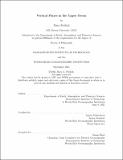Vertical Fluxes in the Upper Ocean
Author(s)
Freilich, Mara
DownloadThesis PDF (63.31Mb)
Advisor
Mahadevan, Amala
Terms of use
Metadata
Show full item recordAbstract
Oceanic fronts at the mesoscale and submesoscale are associated with enhanced vertical motion, which strengthens their role in global biogeochemical cycling as hotspots of primary production and subduction of carbon from the surface to the interior. Using process study models, theory, and field observations of biogeochemical tracers, this thesis improves understanding of submesoscale vertical tracer fluxes and their influence on carbon cycling. Unlike buoyancy, vertical transport of biogeochemical tracers can occur both due to the movement of isopycnals and due to motion along sloping isopycnals. We decompose the vertical velocity below the mixed layer into two components in a Lagrangian frame: vertical velocity along sloping isopycnal surfaces and the adiabatic vertical velocity of isopycnal surfaces and demonstrate that vertical motion along isopycnal surfaces is particularly important at submesoscales (1-10 km). The vertical flux of nutrient, and consequently the new production of phytoplankton depends not just on the vertical velocity but on the relative time scales of vertical transport and nutrient uptake. Vertical nutrient flux is maximum when the biological timescale of phytoplankton growth matches the vertical velocity frequency. Export of organic matter from the surface and the interior requires water parcels to cross the mixed layer base. Using Lagrangian analysis, we study the dynamics of this process and demonstrate that geostrophic and ageostrophic frontogenesis drive subduction along density surfaces across the mixed layer base. Along-front variability is an important factor in subduction. Both the physical and biological modeling studies described above are used to interpret observations from three research cruises in the Western Mediterranean. We sample intrusions of high chlorophyll and particulate organic carbon below the euphotic zone that are advected downward by 100 meters on timescales of days to weeks. We characterize the community composition in these subsurface intrusions at a lateral resolution of 1–10 km. We observe systematic changes in community composition due to the changing light environment and differential decay of the phytoplankton communities in low-light environments, along with mixing. We conclude that advective fluxes could make a contribution to carbon export in subtropical gyres that is equal to the sinking flux.
Date issued
2021-09Department
Massachusetts Institute of Technology. Department of Earth, Atmospheric, and Planetary SciencesPublisher
Massachusetts Institute of Technology